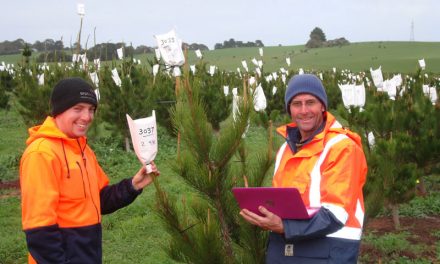A global semiconductor shortage is impacting on a huge range of manufacturers and has left many fishing for chips.
Semiconductors aren’t the first thing you think about when you’re thinking timber. The links between a shortage of the components that are vital for so many electronics and wood products are nowhere near as obvious as the ones between semiconductors and cars or computers. But then you remember how many of our machines, vehicles and systems are automated these days.
What started as a problem in the car and computing industries has spiralled out in recent months. The root causes boil down to strong demand and insufficient supply. During Covid lockdowns, there was a huge demand for home electronics and little for cars. Automotive dealers dropped their future orders and, where possible, electronics manufacturers swept them up.
Then people went back to work, and took driving holidays, and decided they deserved a new car. Auto production bounced back at the same time electronics sales were still high and a whole lot of the people who usually make semiconductors were off work with Covid. Expectations were already unrealistic – there’s a four-month lead time to ramp up production in good years – over 2021/22, they’ve become impossible.
Feeling battered
For some machinery suppliers, it’s a led to a stressful time. TTN spoke to several who didn’t want to be named because they were concerned their customers would worry about their orders.
“We’re doing everything we can to make sure there are no delays,” said one, “but it’s a juggle! We haven’t resorted to the black market yet, but if you see a chap on the news wearing a hoodie and raiding a semiconductor plant, be ready to give me an alibi.”
Another spoke of being so desperate for a single component to fulfil an order that he made a one-off order through a new supplier at 60 times his usual cost.
“The good news is that was 60 times a small amount of money, and we didn’t need many of them. You’ll happily wear that for a one-off, but overall, costs are up about 20% year on year. And that’s not just for us, that’s for everyone supplying every part we use, because they all have the same problem.
“When I put an order in with my American supplier, the cost I’m paying now isn’t the cost I order it at. I’m paying their cost at the time of shipping plus their markup. Now, they’re being very transparent about this, and it is necessary because we can’t ask companies to send themselves out of business covering price rises, but it puts us in the position of having to pass those cost increases on at some point, too.”
After Covid, the pressures of timber shortages, fuel increases, fires and floods, the last thing machinery customers want to hear is about a price rise, or a delivery delay.
“Unfortunately,” says the definitely not a burglar, “that is sometimes the news we have to give. And to their infinite credit, most of our customers are being extraordinarily understanding about it.”
Truck and lifting firms have been hit hardest, as they are in many cases competing directly with larger automotive firms for the same types of chip, which has led to significant price increases. But all machinery and computing manufacturers are having to manage some level of disruption.
“It’s another area where the loss of Australian manufacturing really shows,” says the manufacturer with big cost increases. “Several states have flagged it as an area where they would like to invest in future industry, but even if the approvals were given overnight and ground broken on the project tomorrow, we’re three or more years away from beginning production.”
When the chips are down
Ed Serrano, managing director of Vekta Automation, was happy to speak on the record. “We’ve been lucky in that this hasn’t affected any of our deliveries yet, but that’s thanks to a mixture of planning, adapting what we’re doing and good fortune.”
The first step for Vekta has been to increase its stock holdings. “We’re in a happy place where we could tie up a bit more cash that way and we were still able to get supply for most of our circuit boards,” says Serrano.
“But our supply chains have definitely become more… let’s say dynamic. Every day is a new day and some things that have been available for years are suddenly no longer around.”
He describes the situation as playing by ear and addressing one problem at a time. “The stock holdings are the very first step after that it’s looking at the various options,” Serrano says. “So we source things through our US company. We source things through our normal channels. And we source things through new channels that we’ve developed specifically because of these Covid semiconductor shortages. It’s all just becoming a bit more dynamic.
“It’s no longer as straightforward as you just go to the guy that you could buy supply from in previous years; you’ve got to look around a little bit more.”
While Serrano has been able to manage the challenges for his specific orders so far without major disruptions (different types of chips have different levels of shortages, with automotive supply one of the most constrained at the time of writing), he’s seen others impacted more severely.
“I know another supplier in the US who had some major problems with some key items that they need for their equipment,” says Serrano. “The lead time for their circuit boards, which is what semiconductors are generally going into, suddenly just exploded without any real warning.”
Serrano has had good communication from his suppliers, who are effectively in the same boat with him as electronics rarely go directly from manufacturer to end user. “Where we can, we’ve also broadened our channels,” he says, “but that’s not as simple as it sounds. You’re not looking for a generic product, you’re looking for a specific integrated circuit board that uses specific semiconductors, so the avenues for getting those are often quite limited.”
As a backup, Serrano has also looked at ways he can circumvent the problem. “In some cases, things have been redeveloped to not use particular semiconductors or to use more readily available parts,” he says.
“That’s something that we’ve worked with our suppliers on. And then as a last resort, we’ve looked at having to change some of our designs. We only do this if it’s something where there are pre-existing technical reasons to go in that direction, but we keep it on the cards.”
Serrano gives an example of a product that was slated for a future upgrade and change in some of its functionality.
“We certainly hadn’t scheduled that to happen as early as it turned out,” Serrano says. “But we brought that time frame forward because the semiconductor issues meant that one part in the old model was becoming harder to find while the parts we had designed the new model around were easier to find. So we said, ‘let’s do that work now and knock two birds off with one stone.’”
As an engineer who also runs the business, Serrano acknowledges that he can often be more nimble than businesses with more layers. It also means that more of his customers know him personally, and he is able to convey the problem to them clearly. “As I say, none of our deliveries have been affected yet, but we are seeing impacts, we’ve had a few scares, don’t get me wrong,” says Serrano. “But we try and talk to our customers and let them know what we’re doing about it. Most people know there is some sort of issue and they’re seeing it feeding through the supply chain, so it’s just a matter of explaining what it means in terms of their order.”
In the wider market, the expectation is for the situation to resolve itself mostly over the coming 12–24 months. For some businesses who can make do or mend, that just means a bit of patience. For others, it will mean having some very honest chats with your suppliers and perhaps looking for second-hand or leasing options to fill the gap and keep your productivity growing.









